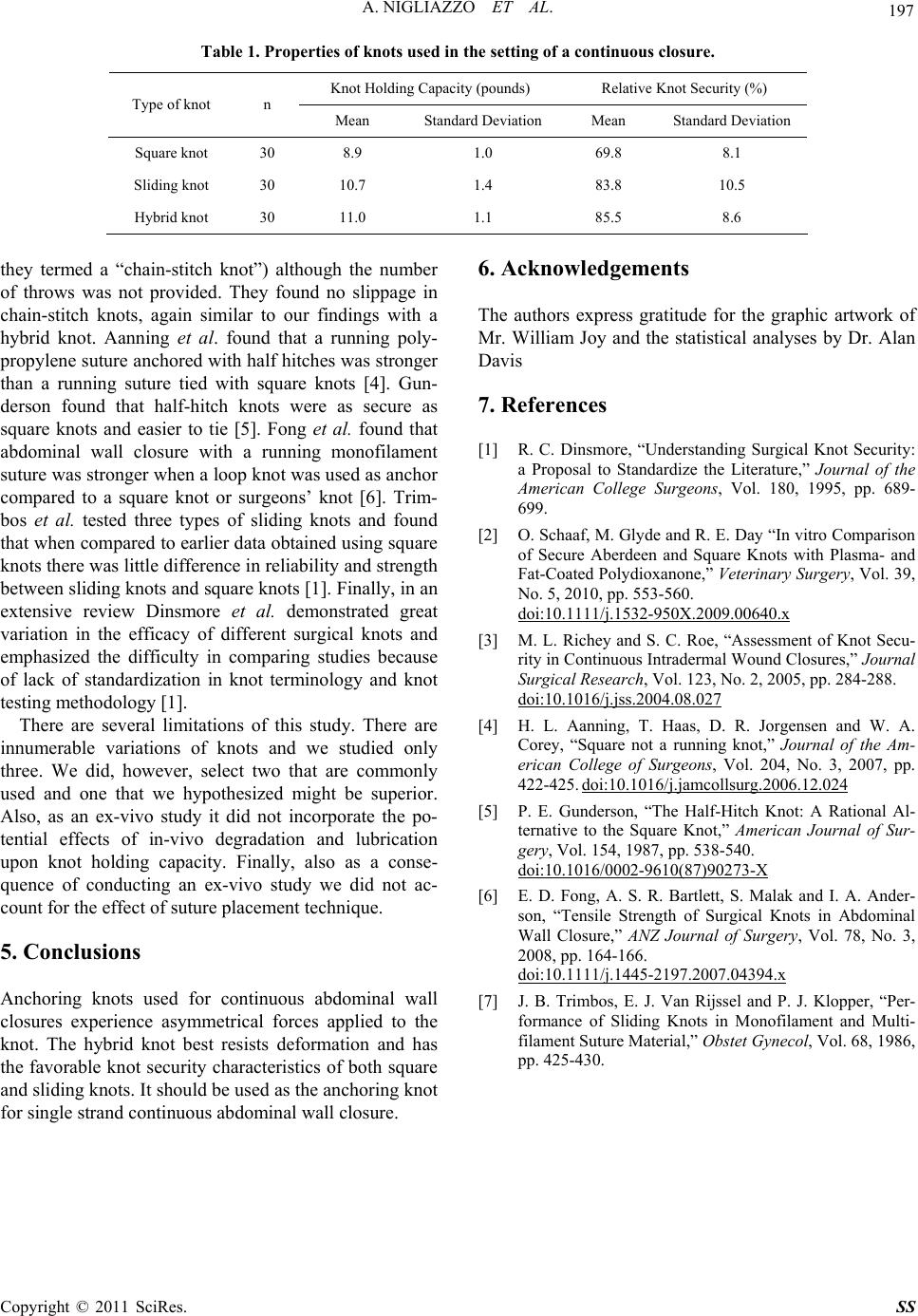
A. NIGLIAZZO ET AL.
Copyright © 2011 SciRes. SS
197
Table 1. Properties of knots used in the setting of a continuous closure.
Knot Holding Capacity (pounds) Relative Knot Security (%)
Type of knot n Mean Standard Deviation Mean Standard Deviation
Square knot 30 8.9 1.0 69.8 8.1
Sliding knot 30 10.7 1.4 83.8 10.5
Hybrid knot 30 11.0 1.1 85.5 8.6
they termed a “chain-stitch knot”) although the number
of throws was not provided. They found no slippage in
chain-stitch knots, again similar to our findings with a
hybrid knot. Aanning et al. found that a running poly-
propylene suture anchored with half hitches was stronger
than a running suture tied with square knots [4]. Gun-
derson found that half-hitch knots were as secure as
square knots and easier to tie [5]. Fong et al. found that
abdominal wall closure with a running monofilament
suture was stronger when a loop knot was used as anchor
compared to a square knot or surgeons’ knot [6]. Trim-
bos et al. tested three types of sliding knots and found
that when comp ared to earlier data ob tained using square
knots there was little difference in reliability and strength
between sliding knots and square knots [1]. Finally, in an
extensive review Dinsmore et al. demonstrated great
variation in the efficacy of different surgical knots and
emphasized the difficulty in comparing studies because
of lack of standardization in knot terminology and knot
testing methodology [1].
There are several limitations of this study. There are
innumerable variations of knots and we studied only
three. We did, however, select two that are commonly
used and one that we hypothesized might be superior.
Also, as an ex-vivo study it did not incorporate the po-
tential effects of in-vivo degradation and lubrication
upon knot holding capacity. Finally, also as a conse-
quence of conducting an ex-vivo study we did not ac-
count for the effect of suture placement technique.
5. Conclusions
Anchoring knots used for continuous abdominal wall
closures experience asymmetrical forces applied to the
knot. The hybrid knot best resists deformation and has
the favorable knot security characteristics of both square
and sliding knots. It should be used as the an chor ing kno t
for single strand con tinuous abdominal wall closure.
6. Acknowledgements
The authors express gratitude for the graphic artwork of
Mr. William Joy and the statistical analyses by Dr. Alan
Davis
7. References
[1] R. C. Dinsmore, “Understanding Surgical Knot Security:
a Proposal to Standardize the Literature,” Journal of the
American College Surgeons, Vol. 180, 1995, pp. 689-
699.
[2] O. Schaaf, M. Glyde and R. E. Day “In vitro Comparison
of Secure Aberdeen and Square Knots with Plasma- and
Fat-Coated Polydioxanone,” Veterinary Surgery, Vol. 39,
No. 5, 2010, pp. 553-560.
doi:10.1111/j.1532-950X.2009.00640.x
[3] M. L. Richey and S. C. Roe, “Assessment of Knot Secu-
rity in Continuous Intradermal Wound Closures,” Journal
Surgical Researc h, Vol. 123, No. 2, 2005, pp. 284-288.
doi:10.1016/j.jss.2004.08.027
[4] H. L. Aanning, T. Haas, D. R. Jorgensen and W. A.
Corey, “Square not a running knot,” Journal of the Am-
erican College of Surgeons, Vol. 204, No. 3, 2007, pp.
422-425. doi:10.1016/j.jamcollsurg.2006.12.024
[5] P. E. Gunderson, “The Half-Hitch Knot: A Rational Al-
ternative to the Square Knot,” American Journal of Sur-
gery, Vol. 154, 1987, pp. 538-540.
doi:10.1016/0002-9610(87)90273-X
[6] E. D. Fong, A. S. R. Bartlett, S. Malak and I. A. Ander-
son, “Tensile Strength of Surgical Knots in Abdominal
Wall Closure,” ANZ Journal of Surgery, Vol. 78, No. 3,
2008, pp. 164-166.
doi:10.1111/j.1445-2197.2007.04394.x
[7] J. B. Trimbos, E. J. Van Rijssel and P. J. Klopper, “Per-
formance of Sliding Knots in Monofilament and Multi-
filament Suture Material,” Obstet Gynecol, Vol. 68, 1986,
pp. 425-430.